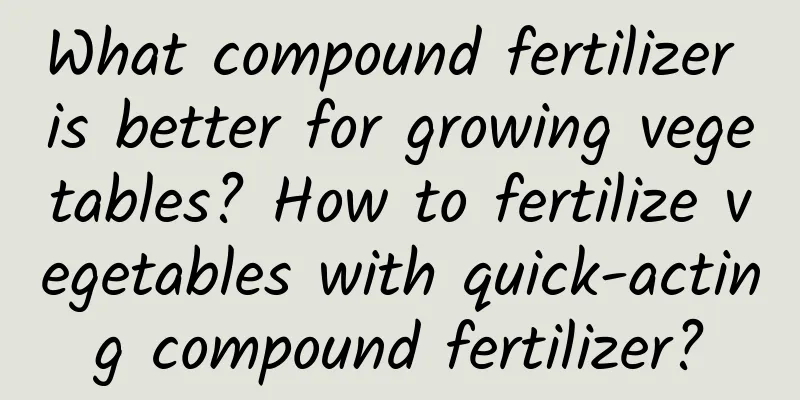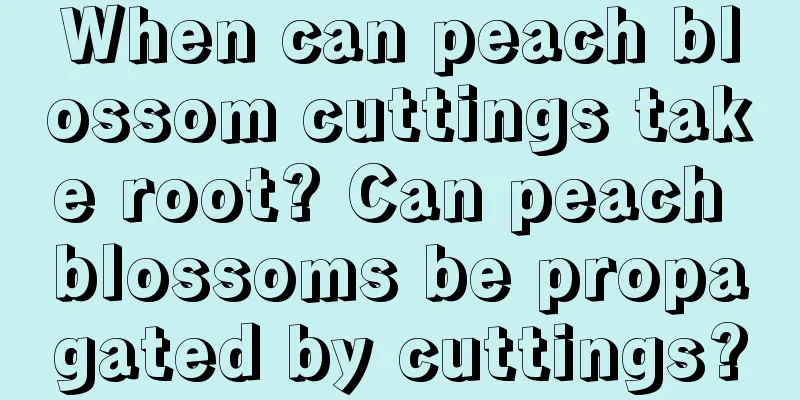What compound fertilizer is better for growing vegetables? How to fertilize vegetables with quick-acting compound fertilizer?

|
Good fertilization is the key to good vegetable cultivation, but fertilizing vegetables is a tedious task. A key point in whether vegetables can be grown well is whether the fertilization is sufficient and reasonable. So what kind of compound fertilizer is better for growing vegetables? What compound fertilizer is good for growing vegetables?1. Leafy vegetables are mainly nitrogen fertilizers Short-term leafy vegetables such as lettuce, cabbage, and water spinach have shallow roots and weak absorption capacity, and their fresh stems and leaves are edible, so they require more nitrogen. They should be applied thinly and frequently, with manure and urine water applied every 3 to 4 days, gradually increasing the fertilizer concentration to promote rapid growth of stems and leaves. Avoid spreading fertilizer on the heart leaves to avoid burning the seedlings. It is best to combine topdressing with watering each time. For head vegetables with a long growth period, such as cabbage and cauliflower, nitrogen fertilizer is also the main fertilizer. In the seedling stage, apply fertilizer thinly and frequently to promote early growth and rapid development. When the leaves begin to form ears and heads, the fertilizer concentration should be increased to make the heads compact. 2. Apply nitrogen fertilizer to beans, and increase the application of phosphorus and potassium fertilizers For legume vegetables such as beans, edamame, soybeans, lentils, and peas, topdressing should be properly controlled before flowering and podding. If there is too much nitrogen fertilizer, the stems and leaves will grow too lush, which will delay flowering and fruiting and reduce yield. Only by applying topdressing after flowering and pod formation can high yields be achieved. At this time, the crop is budding, flowering, and fruiting at the same time, which is a period when vegetative growth and reproductive growth go hand in hand. Fruits and flower buds develop at the same time and compete for nutrients. They are easily affected by environmental conditions such as temperature, light, soil moisture and nutrient status, which can cause various nutritional and physiological disorders, resulting in flower and fruit drop. Nitrogen fertilizers should be applied appropriately, and phosphorus and potassium fertilizers should be added. 3. Melons, fruits and nightshade vegetables These vegetables have many fruits, high yields, and a long harvest period, so they require a large amount of fertilizer that increases gradually. However, we must also master the principle of applying fertilizer thinly and frequently during the seedling stage, and appropriately increase the amount of topdressing each time to meet the nutrients needed during the fruit-bearing period, so that the plants grow strong and prevent leggy growth. Especially for tomatoes, if too much nitrogen fertilizer is applied during the seedling stage, the plants will be delicate and susceptible to diseases. After flowering and fruiting, in addition to adding quick-acting nitrogen fertilizer, you should also apply appropriate amounts of compound fertilizers containing more phosphorus and potassium, or superphosphate, potassium chloride, plant ash, etc. to enhance the plant's resistance to stress, make the fruit plump, and improve quality and yield. How to use compound fertilizer correctly for vegetable cultivation1. Apply compound fertilizer first When the vegetables grow to about 4-5 leaves, take about 20 compound fertilizer granules, then dig a 10 cm deep hole 20 cm away from the vegetables, put the compound fertilizer into the hole, cover the compound fertilizer with soil and water it. 2. Add basal fertilizer After applying compound fertilizer, you can add some base fertilizer to crops, such as cow dung, sheep dung, chicken manure, etc. 3. Lay the covering film After applying compound fertilizer and organic fertilizer into the soil together, cover it with film. This will prevent the nutrients in the fertilizer from being lost and make the organic fertilizer more decomposed. When to add compound fertilizer when growing vegetablesWhen the vegetable has 4 or 5 leaves, you should apply compound fertilizer . Take 20 of them, dig a hole 10 cm deep 20 cm away from the vegetable, put the compound fertilizer in, cover with soil, and water. With each watering, the compound fertilizer slowly melts and is absorbed by the vegetables. Add fertilizer every 15 days to maintain continuous fertility. During the normal planting period, water and compound fertilizer can be applied every 4-7 days. Compound fertilizer is rich in nitrogen, phosphorus and potassium elements, which can provide vegetables with the nutrients they need for growth and accelerate their growth. Then, after using compound fertilizer on the vegetables, you need to water them once to reduce the fertilizer content in the soil to prevent the roots of the vegetables from being burned. |
>>: What compound fertilizer is good for chestnuts? What fertilizer is best for chestnut trees?
Recommend
Phalaenopsis orchid stem cutting method
Phalaenopsis is an indoor plant with great orname...
What is the best month to plant carrots in spring?
When to plant carrots in spring Spring carrots ar...
How many jasmine plants should be planted in one pot and how should they be grown?
1. How many plants can be grown in one pot? Gener...
How to Plant Moringa Seeds
1. Select seeds Not all Moringa tree seeds germin...
Method of sowing seeds of Chrysanthemum
Time to sow chrysanthemum seeds The sowing propag...
How to judge whether Clivia should be watered
1. Listen to the sound This is a method often use...
How to care for Cotinus coggygria bonsai
About the making of tree shape Cotinus coggygria ...
Why do onions die slowly after being planted (What causes the death of onion seedlings)
As the saying goes, "Seven onions and eight ...
Where does mangosteen grow? On trees or on the ground? Where does the mangosteen fruit grow on the tree?
Mangosteen is an evergreen tree that takes more t...
How to maintain the BBK flowers to make them red
Growing conditions of BBK The Bubugao rose flower...
What flowers are suitable for growing in Gannan? What are the city flowers and trees?
1. Climate characteristics of Gannan Gannan's...
How to grow camellia potted plants
Camellia potted plant maintenance Camellia potted...
What are the cultivation methods and precautions of coral sticks?
Coral Stick Introduction Coral stick is also call...
Do you know the nutritional value of strawberries?
1. Eat strawberries before meals to relieve poor ...
Plant a pot of passion fruit on the balcony, the branches will grow quickly through "cuttings", and you will have more fruits every year than you can eat!
Huahua discovered a kind of fruit potted plant a ...









